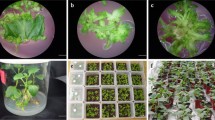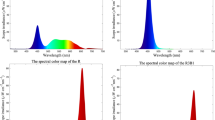Abstract
To elucidate the mechanism of anthocyanin synthesis induction concomitant with chlorophyll degradation, we established a system in which anthocyanin synthesis and degradation of chlorophyll in regenerated torenia (Torenia fournieri) shoots was induced on medium containing 7% sucrose. Here, we studied the effect of several plant-growth regulators on anthocyanin synthesis and the degradation of chlorophyll in the torenia shoot regenerating system. Exogenous abscisic acid (ABA) could induce anthocyanin synthesis and chlorophyll senescence in regenerating torenia shoots on the medium containing a low concentration of sucrose (1.5%). We determined the changes in the amount of endogenous ABA in the regenerated shoots during the process of anthocyanin synthesis on the medium containing 7% sucrose. It was revealed that the 7% sucrose treatment elevated endogenous ABA levels before the induction of anthocyanin synthesis and chlorophyll degradation. However, while retransfer to the 1.5% sucrose medium resulted in a gradual decrease in the ABA level and a failure of induction of anthocyanin synthesis, normal shoot regeneration. These results suggest that changes in the amount of endogenous ABA may play an important role in the induction of anthocyanin synthesis and chlorophyll degradation in regenerated torenia shoots.






Similar content being viewed by others
References
Aida R, Yoshida K, Kondo T, Kishimoto S, Shibata M (2000) Copigmentation gives bluer flowers on transgenic torenia plants with the antisense dihydroflavonol-4-reductase gene. Plant Sci 160:49–56
Arenas-Huertero F, Arroyo A, Zhou L, Sheen J, Leon P (2000) Analysis of Arabidopsis glucose insensitive mutants, gin5 and gin6, reveals a central role of the plant hormone ABA in the regulation of plant vegetative development by sugar. Genes Dev 14:2085–2096
Asami T, Sekimata K, Wang JM, Yoneyama K, Takeuchi Y, Yoshida S (1999) Preparation of (±)-[1,2-13C2] abscisic acid for use as a stable and pure internal standard. J Chem Res (Synop) 11:658
Blazquez MA, Green R, Nilsson O, Sussman MR, Weigel D (1998) Gibberellins promote flowering of Arabidopsis by activating the LEAFY promoter. Plant Cell 10:791–800
Buchholz G, Ehmann B, Wellmann E (1995) Ultraviolet light inhibition of phytochrome-induced flavonoid biosynthesis and DNA photolyase formation in mustard cotyledons (Sinapis alba L.). Plant Physiol 108:227–234
Chalker L (1999) Environmental significance of anthocyanins in plant stress responses. Photochem Photobiol 70:1–9
Cheng WH, Endo A, Zhou L, Penney J, Chen HC, Arroyo A, Leon P, Nambara E, Asami T, Seo M, Koshiba T, Sheen J (2002) A unique short-chain dehydrogenase/reductase in Arabidopsis glucose signaling and abscisic acid biosynthesis and functions. Plant Cell 14:2723–2743
Christie PJ, Alfenito MR, Walbot V (1994) Impact of low-temperature stress on general phenylpropanoid and anthocyanin pathways: enhancement of transcript abundance and anthocyanin pigmentation in maize seedlings. Planta 194:541–549
Deikman J, Hammer PE (1995) Induction of anthocyanin accumulation by cytokinins in Arabidopsis thaliana. Plant Physiol 108:47–57
Ferreres F, Gil MI, Castaner M, Tomas-Barberan FA (1997) Phenolic metabolites in red pigmented lettuce (Lactuca sativa). Changes with minimal processing and cold storage. J Agric Food Chem 45:4249–4254
Finkelstein RR, Gampala SS, Rock CD (2002) Abscisic acid signaling in seeds and seedlings. Plant Cell 14(Suppl):15–45
Gazzarrini S, McCourt P (2003) Cross-talk in plant hormone signalling: what Arabidopsis mutants are telling us. Ann Bot (Lond) 91:605–612
Gong ZZ, Yamazaki M, Saito K (1999) A light-inducible Myb-like gene that is specifically expressed in red Perilla frutescens and presumably acts as a determining factor of the anthocyanin forma. Mol Gen Genet 262:65–72
Gould KS, Markham KR, Smith RH, Goris JJ (2000) Functional role of anthocyanins in the leaves of Quintinia serrata A. Cunn. J Exp Bot 51:1107–1115
Gould KS, Neill SO, Vogelmann TC (2002) A unified explanation for anthocyanins in leaves? Ad Bot Res 37:167–192
Gould KS (2004) Nature’s Swiss army knife: The diverse protective roles of anthocyanins in leaves. J Biomed Biotechnol 2004:314–320
Guruprasad K, Laloraya L (1980) Effect of pigment precursors on the inhibition of anthocyanin biosynthesis. Plant Sci Lett 19:73–79
Huijser C, Kortstee A, Pego J, Weisbeek P, Wisman E, Smeekens S (2000) The Arabidopsis SUCROSE UNCOUPLED-6 gene is identical to ABSCISIC ACID INSENSITIVE-4: involvement of abscisic acid in sugar responses. Plant J 23:577–585
Jensen AB, Busk PK, Figueras M, Mar Alba M, Peracchia G, Messeguer R, Goday A, Pages M (1996) Drought signal transduction in plants. Plant Growth Regul 20:105–110
Kubasek WL, Shirley BW, McKillop A, Goodman HM, Briggs W, Ausubel FM (1992) Regulation of flavonoid biosynthetic genes in germinating Arabidopsis seedlings. Plant Cell 4:1229–1236
Laby RJ, Kincaid MS, Kim D, Gibson SI (2000) The Arabidopsis sugar-insensitive mutants sis4 and sis5 are defective in abscisic acid synthesis and response. Plant J 23:587–596
Machuka J, Bashiardes S, Ruben E, Spooner K, Cuming A, Knight C, Cove D (1999) Sequence analysis of expressed sequence tags from an ABA-treated cDNA library identifies stress response genes in the moss Physcomitrella patens. Plant Cell Physiol 40:378–387
Matile P (2000) Biochemistry of Indian summer: physiology of autumnal leaf coloration. Exp Gerontol 35:145–158
Moalem D, Tamari G, Leitner-Dagan Y, Borochov A, Weiss D (1997) Sugar-dependent gibberellin-induced chalcone synthase gene expression in petunia corollas. Plant Physiol 113:419–424
Murashige T, Skoog F (1962) A revised medium for rapid growth and bioassays with tobacco cultures. Physiol Plant 15:473–497
Nagira Y, Ozeki Y (2004) A system in which anthocyanin synthesis is induced in regenerated torenia shoots. J Plant Res 117:377–383
Ozeki Y, Komamine A (1986) Effects of growth regulators on induction of anthocyanin synthesis in carrot suspension cultures. Plant Cell Physiol 27:1361–1368
Pirie A, Mullins M (1976) Changes in anthocyanin and phenolics content of grapevine leaf and fruit tissues treated with sucrose, nitrate, and abscisic acid. Plant Physiol 58:468–472
Porra RJ, Thompson WA, Kriedemann PE (1989) Determination of accurate extinction coefficients and simultaneous equations for assaying chlorophylls a and b extracted with four different solvents: verification of the concentration of chlorophyll standards by atomic absorption spectroscopy. Biochem Biophys Acta 975:384–394
Rook F, Corke F, Card R, Munz G, Smith C, Bevan MW (2001) Impaired sucrose-induction mutants reveal the modulation of sugar-induced starch biosynthetic gene expression by abscisic acid signalling. Plant J 26:421–433
Seitz U, Heinzmann U (1975) [The influence of gibberellic acid on the synthesis of anthocyanin in tissue cultures of Daucus carota (author’s transl)]. Planta Med (Suppl):66–69
Shirley B (1996) Flavonoid biosynthesis: ‘new’ functions for an ‘old’ pathway. Trends Plant Sci 11:377–382
Walton DC, Sondheimer E (1968) Effects of abscisin II on phenylalanine ammonia-lyase activity in excised bean axes. Plant Physiol 43:467–469
Weiss D, Van Der Luit A, Knegt E, Vermeer E, Mol J, Kooter JM (1995) Identification of endogenous gibberellins in petunia flowers (induction of anthocyanin biosynthetic gene expression and the antagonistic effect of abscisic acid). Plant Physiol 107:695–702
White CN, Rivin CJ (2000) Gibberellins and seed development in maize. II. Gibberellin synthesis inhibition enhances abscisic acid signaling in cultured embryos. Plant Physiol 122:1089–1097
Xiong L, Schumaker KS, Zhu JK (2002) Cell signaling during cold, drought, and salt stress. Plant Cell 14(Suppl):165–183
Zeevaart J, Creelman R (1988) Metabolism and physiology of abscisic acid. Ann Rev Plant Physiol Plant Mol Biol 39:439–473
Acknowledgments
A part of this work was supported by Grants-in-Aid for Scientific Research from the Ministry of Education, Science, Sports and Culture of Japan.
Author information
Authors and Affiliations
Corresponding author
Rights and permissions
About this article
Cite this article
Nagira, Y., Ikegami, K., Koshiba, T. et al. Effect of ABA upon anthocyanin synthesis in regenerated torenia shoots. J Plant Res 119, 137–144 (2006). https://doi.org/10.1007/s10265-005-0256-9
Received:
Accepted:
Published:
Issue Date:
DOI: https://doi.org/10.1007/s10265-005-0256-9




